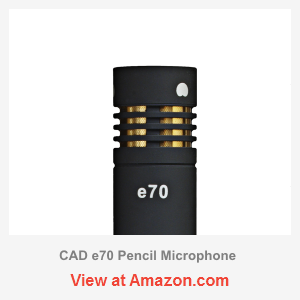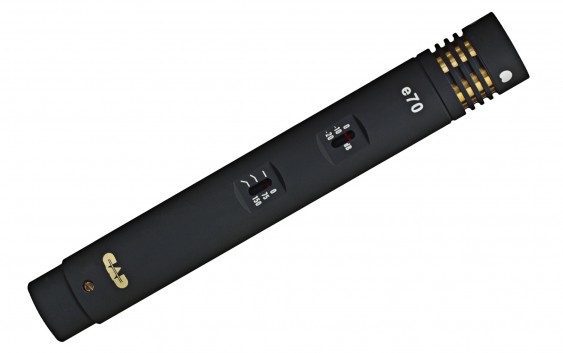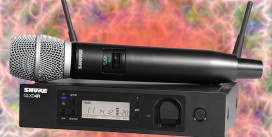CAD e70 is an excellent quality pencil mic with interchangeable omni and cardioid capsules. Very natural sounding, it is crisp and has plenty of air with a nice sparkling flavor. This mic also features fine low end, which really nails the sound of an acoustic guitar. Not thin, not too deep, and just about right to handle the most instruments. There are of course exceptions: if you want to achieve warmer and richer sound, you’re better off with an LDC. However, for a small diaphragm condenser, e70 sounds really great and I would pick it over the other mics in the sub $200 range.
Instruments
CAD e70 is best at handling instruments: acoustic guitar, banjo, piano and violin are just a few of the examples that come to mind. I have stumbled on a YouTube video from GarageBand & Beyond that actually demonstrates how it sounds on acoustic guitar without any EQ or compression. It is self-explanatory so just listen and judge for yourself! And if you like this sound, you will probably like it for other instruments as well.
Percussion
CAD e70 also works for percussion, particularly small frame drums and tambourines. It gives you a precise attack without leaving out any details. There is enough brightness if you want, and no it doesn’t sound hyped. The low end is not deep enough for large drums but it is accurate and won’t make your tambourine sound like kick drum. Being a condenser mic, at times it can run hot. But this is not an issue, since all you need to do is to move it closer to the source. CAD e70 has no problems with close miking, especially with pad on, and if needed it is ready to handle a substantial amount of sound pressure.
Overheads
 Cymbals and hi-hat performance is just slightly above average. Even though the mic is relatively cheap, it has an excellent transient performance while the frequency response fully extends to 20 kHz. Thus, it is capable of capturing the entire range, with all the subtleties. However, in practice it sounds a bit too bright, and may require a good deal of EQ to balance it out. For cymbals and hi-hat, it is preferable to use higher quality mics with flatter response. A pair of Shure SM81 would accomplish this task much better… But if you cannot afford more expensive overheads, this mic can cut it as a budget option.
Cymbals and hi-hat performance is just slightly above average. Even though the mic is relatively cheap, it has an excellent transient performance while the frequency response fully extends to 20 kHz. Thus, it is capable of capturing the entire range, with all the subtleties. However, in practice it sounds a bit too bright, and may require a good deal of EQ to balance it out. For cymbals and hi-hat, it is preferable to use higher quality mics with flatter response. A pair of Shure SM81 would accomplish this task much better… But if you cannot afford more expensive overheads, this mic can cut it as a budget option.
Omni capsule
So far, I’ve been referring to the cardioid capsule but it also comes with a separate omnidirectional capsule. This capsule offers a similar amount of brightness though in a slightly different range. There is a bit more raw presence but it is not as airy as the cardioid. It’s not at all gimmicky, as you may think – the quality is just about decent. It will prove quite useful if you want to capture room reverb or ambience. In addition, this can be a great budget solution for recording choirs and orchestra. A pair of e70 in omnidirectional mode will give you a nice sense of depth and spaciousness – for a laughable price.
Noise figures
CAD e70 is rated for 23 dB-A self-noise and 10 mV/Pa sensitivity. There are plenty of both noisier and quieter mics in sub $200 range, so in this regard it can be considered as average. Keep in mind though, quieter mics are not necessarily better sounding and I’d rather use a noisier than a harsher-sounding mic. Comparing to our recently reviewed AKG C1000s, it is actually 2.4 dB quieter when the gain is matched. Comparing to the SM81 mentioned above, it is 2 dB noisier, but it’s actually a bummer for Shure, as it should be even quieter, considering the price.
For home studios and live venues, those figures will be more than enough. When miking instruments at reasonable distance and volume, in other words using it as intended, you won’t hear any hiss or noise whatsoever. The omni capsule is also significantly quieter, so once again it won’t be a problem if you intend recording the ambience of a typical hall. The noise would only reach the threshold of hearing if you were trying to use the directional capsule to capture low volume conversations. Especially from afar while applying lots of gain, but obviously, it is not designed for that.
Features and build
CAD e70 has a nice and solid look, it is lightweight but it feels quite durable. As already mentioned, it comes with two separate capsules. I say this again because in contrast, AKG C1000s uses only single capsule and relies on a cheap looking plastic cap that acts as a polar pattern converter. This really makes me wonder why C1000s is about twice more expensive than e70 – maybe it should be the other way around? Both mics come with wind foams and thread mounts. But behold, e70 also comes with a shock mount, which of course, is only basic… but hell it’s free and it works!
This mic has three-position low cut and pad switches. Low cut can be set at 75 Hz and 150 Hz – both are 6 dB per octave, so it makes a smooth transition. It can be quite useful for close miking to compensate for proximity effect, as well as reducing low frequency machinery noise, such as from air conditioners, etc. The pad options are -10 dB and -20 dB, which I hope does not require explanation. Finally, it relies on phantom power to operate, consuming 2mA @ 48 volts. If powered by digital recorders, it will drain them pretty quickly so plan your production accordingly.
Edit 2019: the original model was reviewed at $99.99 (please note, the older reviews did not include this piece of information). A few years later I see this mic sold for $299, which may look funny but I feel sorry for those who actually paid full price for this somewhat dated model, which is not at all bad but it just wasn’t supposed to compete in this price range. Hence the rating has been adjusted accordingly, also no longer editor’s choice. For other older reviews where the reference price was avoided I’ll try to keep the ratings in regards to price up to date to the best of my ability.
Edit 2020: I see the mic’s price is back the original $200, so I’m going to adjust the rating once again. For this price I don’t know if there are better deals out there, but it certainly works and it’s a good mic to have still, especially if you are afraid to experiment… $300 was overkill though.
Pros
|
Cons
|










Interested to know what the longer term reliability of this is, as CAD have had some issues with breakdowns in the past.
Yes that’s true, CAD also has some cheap mics with uhm.. questionable quality, but this one is rather solid.
I’m not sure though, why the price is so high on it right now. I remember seeing it around $100, maybe it was on sale.
it was worth it at $100, for me not so much at $200 plus
get one used.. they are out there